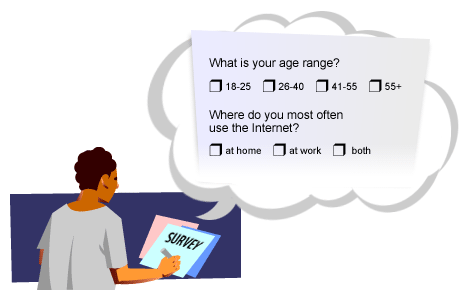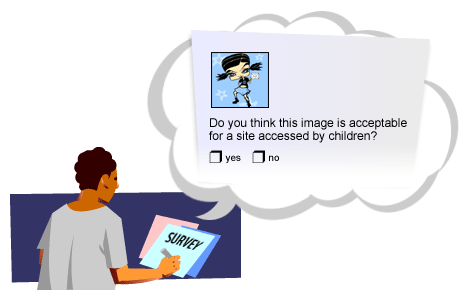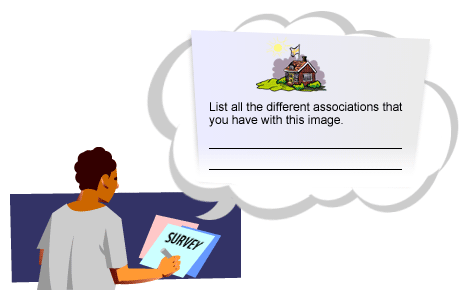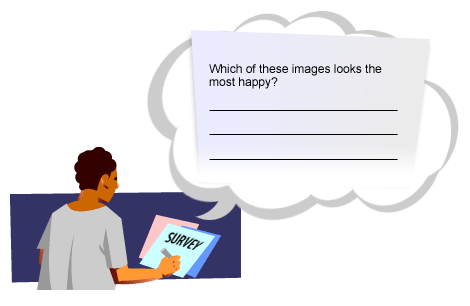| Lesson 8 | Market research question strategies |
| Objective | Describe how to create effective questions for audience analysis. |
Market Research Question Strategies
Successful data gathering requires that you ask the correct questions.
While no set of questions exists that will be correct for every audience, you are more likely to find the information you need if you plan your questions carefully.
- Structure of a Question:
The structure of a question determines the range of responses you will receive. Variety is important: if you ask only one kind of question, you will almost certainly narrow your range of responses. The following series of images below shows a sampling of the kinds of questions that will help you determine sign and metaphor needs.
Audience Analysis Questions





Audience Analysis
Types of Questions for Audience Analysis
An audience analysis is a task that instructional designers and training developers perform in the initial phases of planning a training project. Completing an audience analysis is critical because in order to communicate information effectively, you need to understand who your learners are. Depending on the project, you might have more than once audience. To complete your audience analysis, you will need to interview and observe the employees and management to gather information about your learners. Once you have identified your specific audiences, you can tailor your courses so they are pertinent to the different background, education levels, etc. Here is an example of how audiences can vary widely, even within one organization: you are developing software training for a large organization with a manufacturing facility. Some of your learners are engineers who work in software development. They are technically savvy, work at a computer all day and are already familiar with the software you are training them on. Meanwhile, your second audience is the workers from manufacturing facility. They work with machinery all day and barely use the computer. This will be their first time ever seeing this software. You can already see that, even though these two audiences may need to be trained on the same software, very different approaches will be required for different audiences.
- Behavioral Targeting and Personalization
Several recent studies have explored the virtues of behavioral targeting and personalization for online advertising. A business needs to develop a system of parameters for the prediction of demographic web site visitor profiles, that can be used for web advertising targeting purposes[1]. The methodology involves the transformation of web site visitors’ clickstream patterns to a set of features and the training of Random Forest classifiers that generate predictions for gender, age, educational level and occupation category. These demographic predictions can support online advertisement targeting.
- as an additional input in personalized advertising or behavioral targeting, in order to restrict ad targeting to demographically defined target groups, or
- as an input for aggregated demographic web site visitor profiles that support marketing managers in selecting web sites and achieving an optimal correspondence between target groups and web site audience composition. The proposed methodology is validated using data from a Belgian web metrics company. The results demonstrate that Random Forests demonstrate superior classification performance over a set of benchmark algorithms. Further, the ability of the model set to generate representative demographic web site audience profiles is assessed. The stability of the models over time is demonstrated using out-of-period data.
Special Questioning Concerns
Some of the issues you have learned about as concerns of sign and metaphor design can be specifically addressed through audience questioning.
You may want to look at cultural concerns, context-specific responses, and work-language and specialized language.
- Cultural differences: People from different cultural backgrounds may interpret signs and metaphors differently. Meanings and connotations for images, colors, words, or punctuation may be very different for different cultures. For example, when email applications first began using the U.S.-style mailbox as an icon, some non-Americans used to other kinds of mailboxes did not immediately recognize the meaning of the icon.
- Context-specific Responses: People often respond to signs and metaphors in relation to their immediate context and surroundings. If they are at work when they view a Web site, the setting may influence their response or their interpretation. For example, an image that suggests risk (such as a fast sports car on a mountain road) may not elicit a positive response in a setting where risk management is important, even though it may be an appealing image in other contexts. Audio files are almost always inappropriate for users in school or work environments.
- Work language and Specialized Language: Some sites that are targeted towards specific populations need to take into account the work language or specialized language of those groups. For example, if a Web site is designed as a life insurance portal, it would be important to understand what kinds of terminology the target audience understands. Audience analysis would need to determine what terms need to be explained, and what terms the target audience can be assumed to understand.
Analysis of Competitors:
In strategizing sign and metaphor approaches, it is crucial to examine what your competitors are doing. This is referred to as market intelligence and is part of the responsibility of the Internet Business Strategist. On the Web is it is very easy to examine your competitors' collateral, or promotional materials, so it is possible to stay well informed of the sign and metaphor approaches of key competitors. Without this knowledge, it will be difficult to establish a truly distinct online identity that sets you apart from the competition. In addition, you may observe effective ways that a competitor has segmented a market. You may be able to improve upon innovative ideas they have tried but failed at. A competitor may have just implemented your killer app, in which case you may choose not to spend excessively on development, only to appear to be an imitator. You may find that a strong competitor does a poor job online. That has implications for marketing dollars spent on web vs. other advertising media. You can also learn from sites that have comparable business models, but which are not direct competitors. For example, if you are designing a portal for herbal health products, you might examine portals geared towards exercise equipment and accessories.
In the next lesson, how to further analyze your audience and apply the results to your design choices will be discussed. The following section discusses the different types of questions for audience analysis.
In the next lesson, how to further analyze your audience and apply the results to your design choices will be discussed. The following section discusses the different types of questions for audience analysis.
Types of Questions for Audience Analysis
- Demographic questions: Allow questioner to match trends to specific user groups.
- Structured Questions: Elicit data that will be of a consistent type. Limiting the possible results makes it easier to score and compare data.
- Unstructured or open-ended questions:
Respondents can share types of info you may not have expected.
- Feeling questions: Give insight on people's emotional responses to specific signs and metaphors.
- Detail questions: Provide additional details that respondents may not have given otherwise.
Examples of Demographic Questions
Demographic questions are an important aspect of any survey. Demographic questions are designed to help survey researchers determine what factors may influence a respondent's answers, interests, and opinions. Collecting demographic information will enable you to cross-tabulate and compare subgroups to see how responses vary between these groups.
Demographic Survey Question Examples
Demographic Survey Question Examples
- Age (or birth date)
Age is one of the most common demographic questions asked in surveys. How old a person is will often determine his/her knowledge and experience with the focus of the survey. When administering a survey about consumer electronics, a respondent in his 20s will most likely answer the question differently than a respondent his 70s. Asking a respondent about Age is often one of the first demographic questions asked in a survey.
Question: hat is your age?- Under 12 years old
- 12-17 years old
- 18-24 years old
- 25-34 years old
- 35-44 years old
- 45-54 years old
- 55-64 years old
- 65-74 years old
- Ethnicity:
Capturing a respondent's ethnicity or race is another common demographic question. A person's ethnicity or culture may influence his/her responses to survey questions. Answers may be influenced by the respondents experiences with the survey topic. For example, someone raised in a rural Native American culture may respond to questions about topics such as the environment differently from someone raised in an urban culture.
Question: Ethnicity origin (or Race): Please specify your ethnicity.- White
- Hispanic or Latino
- Black or African American
- Native American or American Indian
- Asian / Pacific Islander
- Other
- Education:
Asking a respondent what their highest level of education completed is often found on surveys. Respondents who completed a four-year degree at a college or university may answer questions differently than those whose education ended in high school.
Question: Education: What is the highest degree or level of school you have completed? If currently enrolled, highest degree received.- No schooling completed
- Nursery school to 8th grade
- Some high school, no diploma
- High school graduate, diploma or the equivalent (for example: GED)
- Some college credit, no degree
- Trade/technical/vocational training
- Associate degree
- Bachelor's degree
- Master's degree
- Professional degree
- Doctorate degree
[1]
Targeting: Targeting is the process of selecting the correct keywords in order to get web page on the first page of Google. Targeting links the desired effects to actions and tasks. The targeting process can be generally grouped into two categories: deliberate and dynamic.